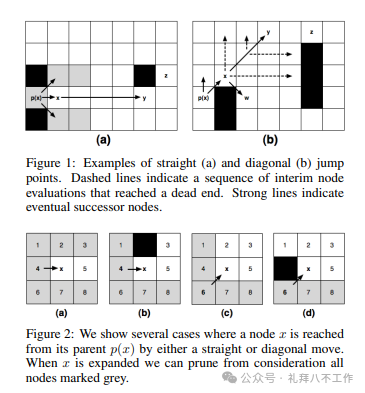A* JPS寻路算法的探讨
A*(A-star)寻路算法是一种基于启发式搜索的路径规划算法,常用于游戏开发和人工智能领域,JPS是A*算法的一个优化算法,咱们就先做一段简单的A*算法介绍,后续再进行JPS算法的进一步探讨。
- A* 要素说明:
- 开启节点列表(OpenList):存放待检测的节点。
- 关闭节点列表(ClosedList):存放不会被检测的节点。
- G 值:从初始节点到任意节点的代价。
- H 值:从节点到目标点的启发式评估代价。
- F 值:G 值和 H 值之和。
- A* 算法通过在二维数组或网格中寻找两点之间的最短路径,结合启发式评估来快速确定路径,算法核心是选择 F 值最小的节点进行扩展,直到找到终点或遍历完所有节点。
- 实现步骤:
- 从 OpenList 中选择 F 值最小的节点(如果 F 相同,选取 H 最小的)。
- 遍历该节点周围的相邻节点:
- 如果没有找到终点,继续循环。
- 如果相邻节点不在 OpenList 中,计算其 G 值和 H 值,并设置父节点为当前节点,加入 OpenList。
- 如果相邻节点已在 OpenList 中,更新其 G 值为较小的值,重新设置父节点。
- 如果遍历到终点,回溯路径,找到最终路径。
- 创建一个节点类,包含节点是否可通过、世界坐标、网格坐标、G 值、H 值和父节点信息。
- 创建网格,初始化节点列表,设置节点是否可通过。
- 将起点放入 OpenList 中。
- 循环执行以上步骤 可参考下面的C#代码案例:
public List<Node> FindPath(Node start, Node end)
{
List<Node> openList = new List<Node>();
HashSet<Node> closedList = new HashSet<Node>();
openList.Add(start);
while (openList.Count > 0)
{
Node currentNode = openList[0];
for (int i = 1; i < openList.Count; i++)
{
if (openList[i].f < currentNode.f || (openList[i].f == currentNode.f && openList[i].h < currentNode.h))
{
currentNode = openList[i];
}
}
openList.Remove(currentNode);
closedList.Add(currentNode);
if (currentNode.x == end.x && currentNode.y == end.y)
{
return GetPath(currentNode);
}
//List<Node> neighbors = GetNeighbors(currentNode, end);
List<Node> neighbors = GetNeighbors8(currentNode);
foreach (Node neighbor in neighbors)
{
if (closedList.Contains(neighbor) || map[neighbor.x, neighbor.y] == 1)
continue;
float newCost = currentNode.g + GetMoveCost(currentNode, neighbor); // 计算移动代价
if (newCost < neighbor.g || !openList.Contains(neighbor))
{
neighbor.g = newCost;
neighbor.h = Heuristic(neighbor, end);
neighbor.parent = currentNode;
if (!openList.Contains(neighbor))
openList.Add(neighbor);
}
}
}
return null;
}
private List<Node> GetNeighbors(Node node, Node end)
{
List<Node> neighbors = new List<Node>();
for (int dx = -1; dx <= 1; dx++)
{
for (int dy = -1; dy <= 1; dy++)
{
// 跳过当前节点
if (dx == 0 && dy == 0)
continue;
// 如果当前节点是斜对角方向的邻居,检查其是否可行
if (dx != 0 && dy != 0)
{
int nx = node.x + dx;
int ny = node.y + dy;
if (nx >= 0 && nx < width && ny >= 0 && ny < height && map[nx, ny] != 1)
{
neighbors.Add(new Node(nx, ny));
}
}
// 如果当前节点是水平或垂直方向的邻居,检查其是否可行
else
{
int nx = node.x + dx;
int ny = node.y + dy;
if (nx >= 0 && nx < width && ny >= 0 && ny < height && map[nx, ny] != 1)
{
neighbors.Add(new Node(nx, ny));
}
}
}
}
return neighbors;
}
private float GetMoveCost(Node fromNode, Node toNode)
{
// 如果两个节点在水平、垂直或对角线方向上相邻,则返回固定的代价值
if (Math.Abs(fromNode.x - toNode.x) + Math.Abs(fromNode.y - toNode.y) == 1) // 水平或垂直移动
{
return 1f;
}
else // 对角线移动
{
return 1.414f; // 对角线移动的代价通常是水平或垂直移动的 sqrt(2) 倍
}
}
咱们看完了A*的原理,回到主题再来讨论下JPS算法,下面这段介绍来自维基百科:
Jump Point Search (JPS) 是对 A* 搜索算法在均匀代价网格上的一种优化。它通过图剪枝来减少搜索过程中的对称性,从而消除了网格中某些节点,前提是满足与网格相关的某些条件。因此,该算法可以考虑沿着网格的直线(水平、垂直和对角线)进行较长的“跳跃”,而不是普通 A* 考虑的从一个网格位置到下一个网格位置的小步。JPS 保持了 A* 的最优性,同时可能将其运行时间缩短一个数量级。
下面的参考图(直跳a和斜跳b)来自 Harabor, Daniel; Grastien, Alban. "Improving Jump Point Search" (PDF). Australian National University College of Engineering and Computer Science. Association for the Advancement of Artificial Intelligence (www.aaai.org). Retrieved 11 July 2015.

- A* 算法回顾:
- A* 算法是一种启发式搜索算法,用于在图或网格上寻找最短路径。
- 它通过估计每个节点到目标的代价(通常使用启发式函数)来选择下一个节点进行扩展。
- A* 算法维护一个开放列表(Open List)和一个关闭列表(Closed List),其中存储了待扩展的节点和已经处理过的节点。
- JPS 算法的优化:
- 只关注所谓的“跳跃点”,而不是所有邻居点,在每个搜索步骤中,通过跳过中间的空白节点,直接跳到可能是最优解的位置(Jump Point)。这样可以减少搜索空间,提高搜索效率。
- 在每个节点处进行跳跃,以确定是否存在“强制邻居”(forced neighbors)。如果存在强制邻居,则在这些强制邻居之间不需要再次搜索,可以直接跳到下一个强制邻居,从而减少搜索量。
private List<Node> GetNeighbors(Node node, Node end)
{
// 初始化一个空的邻居节点列表
List<Node> neighbors = new List<Node>();
// 计算当前节点与终点的相对位置
int dx = Math.Sign(end.x - node.x);
int dy = Math.Sign(end.y - node.y);
// Math.Sign(x)函数接受一个参数x,并返回以下值之一:
// 如果x为正数,则返回+1。
// 如果x为零,则返回0。
// 如果x为负数,则返回-1。
// 如果 dx 和 dy 同时为0,表示当前节点与终点重合,直接返回空列表
if (dx == 0 && dy == 0)
return neighbors;
// 如果 dx 和 dy 其中一个为0,表示当前节点沿着水平或垂直方向移动
if (dx == 0 || dy == 0)
{
// 检查水平方向上的邻居
if (dx != 0)
{
int nx = node.x + dx;
int ny = node.y;
// 检查节点是否越界,并且是否是强制邻居
if (nx >= 0 && nx < width && map[nx, ny] != 1)
{
neighbors.Add(new Node(nx, ny));
}
}
// 检查垂直方向上的邻居
else
{
int nx = node.x;
int ny = node.y + dy;
// 检查节点是否越界,并且是否是强制邻居
if (ny >= 0 && ny < height && map[nx, ny] != 1)
{
neighbors.Add(new Node(nx, ny));
}
}
}
// 如果 dx 和 dy 同时不为0,表示当前节点沿着斜对角方向移动
else
{
int nx = node.x + dx;
int ny = node.y + dy;
// 检查节点是否越界,并且是否是强制邻居
if (nx >= 0 && nx < width && ny >= 0 && ny < height && map[nx, ny] != 1)
{
neighbors.Add(new Node(nx, ny));
}
// 检查斜对角方向上的强制邻居
if (map[node.x, ny] != 1)
{
neighbors.Add(new Node(node.x, ny));
}
if (map[nx, node.y] != 1)
{
neighbors.Add(new Node(nx, node.y));
}
}
// 返回邻居节点列表
return neighbors;
}
本文参与 腾讯云自媒体同步曝光计划,分享自微信公众号。
原始发表:2024-05-09,如有侵权请联系 cloudcommunity@tencent.com 删除
评论
登录后参与评论
推荐阅读

